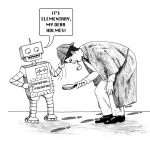Yesterday the UPS deliveryman left a heavy box on my doorstep. Sender: American Mathematical Society. I knew immediately what it was: the complimentary copies of my new book, What’s Happening in the Mathematical Sciences, Vol. 9.
As you can tell from my Web page, What’s Happening (or WHIMS for short) is an ongoing series of books that I write roughly every two or three years for the AMS. I spent about 75 percent of my work time last year putting Volume 9 together, so it’s a great feeling of accomplishment to see the finished product. It looks really sharp!
The articles in WHIMS are written at varying levels of mathematical sophistication, but most of them should be easily understandable to a high-school student who is interested in math, and they all should be understandable to a college math student. Many of them have to deal with current events outside of mathematics, and so you might find it interesting to read about “the math behind the news.”
Here is a brief table of contents:
- Massive Breakthrough. The discovery of the Higgs boson.
- Tubing Through Hyperspace. The solution of the Willmore Conjecture and two other problems, all having to do with inner tubes!
- Tsunamis: Learning from Math, Learning from the Past. The title says it all.
- Today’s Forecast: Ten Percent Chance of Burglary. Predictive policing — a concept first tried out right here in Santa Cruz!
- Topologists Cross Four Off “Bucket List.” Last year William Thurston, one of the greatest 20th-century American mathematicians, passed away. Just before he died, four problems that he posed in the early 1980s were finally solved.
- Mathematicians Do the Twist. The math of Rubik’s cube. With some cool photos that I took! (See below.)
- The Right Epidemic at the Right Time. The flu pandemic of 2009 didn’t kill millions of people, thank goodness, but it did provide a great test of mathematical models to predict the spread and severity of the outbreak.
- Thinking Topically. “Topic modeling” is a hot new way to browse large text databases, and perhaps stop cyber-bullying.
- Thinking Tropically. Tropical geometry is a new “stick figure” approach to algebraic geometry that also has applications to string theory (in physics) and evolutionary trees (in biology).
As usual, WHIMS has lots of pictures and photographs. Two of my favorites are photos that I took of a speedcuber, Lucas Garron, during a Rubik’s Cube competition. I’m not a great photographer and ordinarily I leave the pictures to others. (99 percent of the pictures in the book are not produced by me.) But I just love this pair of photos because they show the split-second speed of Rubik’s cube solvers. The first one shows how speedcubers can spin a layer of cubies with just one finger. The second one shows Garron throwing down the cube at the moment of completion. Even though one face is slightly askew, this will count as a valid solution.
If you’re interested in getting a copy of WHIMS, you can either pre-order it at Amazon.com or order it from the publisher, the American Mathematical Society. List price is $25, price for AMS member is $20, and the price if you order it through Amazon is $17.64. According to Amazon, the official publication date is May 16.






